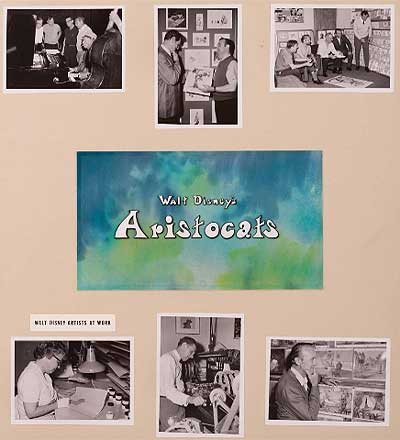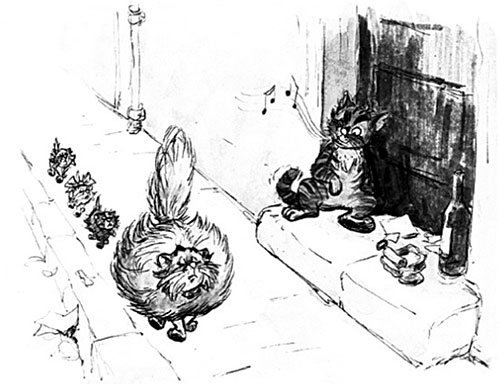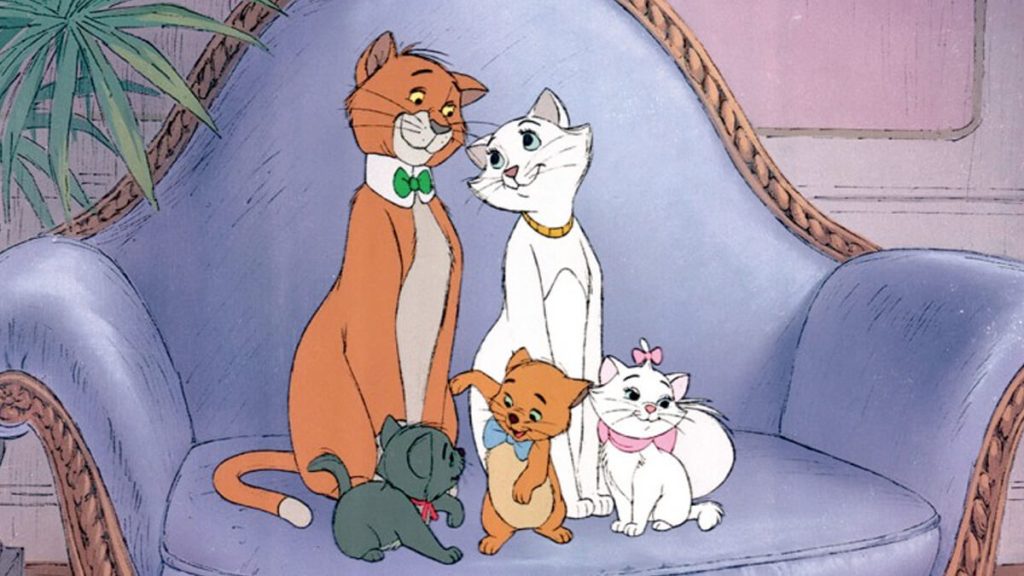The full-length animated features that Walt Disney Animation Studios has produced over the past 75 years can mostly be sorted into two distinctly different piles: Those films that Walt personally had a hand in and those movies which were produced after Disney passed away.
Please note that I said “mostly.” Because the jury’s still out about which pile “The Aristocats” actually belongs in.
Why For? Because prior to his death in December of 1966, Walt spent five years working on & off on the development of this project. As he and his storymen struggled to get “The Aristocats” in good enough shape to shoot.

And — yes — I said “shoot,” rather than animate. For much of the early 1960s, “The Aristocats” was headed for television. Walt originally saw Tom McGowan & Tom Rowe‘s story as perfect fodder for a fun live-action episode of “The Wonderful World of Color.” So from December 1961 ’til August 1963, that’s where the Company’s efforts (at least as far as this individual project was concerned) were concentrated. Breaking down “The Aristocats” ‘s story beats so that this feline-driven tale could then be told as a two-part episode on this hour-long anthology series for NBC.
But sometime in the late Summer / early Fall of 1963 (Just as Walt was riding herd on the production of “Mary Poppins” as well as zeroing in on the perfect piece of property to build Project Florida upon), Woolie Reitherman somehow got ahold of the script for “The Aristocats.” Which he immediately saw as the possible follow-up project for the animated feature that WDAS then had in production, “The Jungle Book.”
Now this is where this story gets kind of murky. Given that — from the Fall of 1964 through December of 1966 — Walt (when he sat in on “Aristocats” story sessions. Which admittedly wasn’t all that often) always pushed for one particular version of this story. Which had Duchess obsessed with finding just the right owner/home for each of her three kittens. The perfect place where Berlioz, Marie and Toulouse’s talents would then be allowed to flourish. More importantly, where her children would be safe, happy and loved for the rest of their lives.

That — to Walt’s way of thinking, anyway — is what should have driven the story of “The Aristocats.” That by placing this particular storyline front & center and then making the whole butler-and-maid-trying-to-dispose-of-this-quartet-of-cats-so-that-they-could-then-collect-Madame-Bonfamille’s-fortune idea a relatively minor comic subplot … Well, that then would have given “The Aristocats” ‘s plotline a real sense of urgency. More importantly, that this mother-who-makes-sacrifices,-lets-her-children-go-so-that-they-can-then-go-on-to-lead-happy,-fulfilling-lives angle is what would give this motion picture heart and allow the audience to make a real emotional connection to these characters and this story. Because — as you know — in all of the very best Walt Disney Studios productions — ” … for every laugh, there should be a tear.”
But after Walt died in December of 1966, Woolie began making significant changes to “The Aristocats” characters & storyline. To be blunt, Reitherman wasn’t all that interested in making an mushy and emotional animated feature. What he had in mind was more of an action-adventure / comedy romp, something more along the lines of Walt Disney Productions’ 1961 release, “101 Dalmatians.”
More to the point, Woolie’s main goal here was to make sure that WDAS would actually be able to complete production of “The Aristocats.” With Walt now gone … Well, there were a lot of people at the Studio who were questioning whether Walt Disney Productions should even keep its feature animation unit up and running.
“The Jungle Book” ‘s huge box office success during the Summer of 1967 effectively tabled that discussion. For a while, anyway. But Reitherman knew that — were “The Aristocats” to turn out to be a particularly troubled production and/or a box office failure … Well, Card Walker & his cronies would then just use this as an excuse to shut feature animation down.
So whatever Woolie could do to make “The Aristocats” easier to produce / keep this animated feature’s overall production costs down, he did. Take — for example — the two villains who used to drive this film’s story, Edgar the Butler and Elvira the Maid. In an effort to simplify these proceedings / streamline production, Reitherman gave the maid the boot and made the butler the singular villain of the piece.
Likewise remembering all of the extra time, effort & money that went into making sure that Shere Khan’s stripes were always in the right place (not to mention all of those spots on the puppies in “101 Dalmatians”) … Well, that’s why Woolie decided to rethink the look that the Studio’s development team had originally come up with for O’Malley the Alley Cat. Changing this sweet-talking tabby from an orange-colored calico with all sorts of stripes on him to a far simpler-to-paint-and-draw, brown-and-white alley cat.
Mind you, not everyone at the Studio was happy with what Woolie Reitherman was doing. When I spoke with Disney Legend Richard Sherman on the phone last week (he was doing publicity for the Blu-ray version of “The Aristocats.” Which — FYI — is out in stores today), he talked about how all of these cuts & changes that Woolie was making wound up impacting many of the songs that he and his brother Robert had written for this film.
“As you’ll discover when you watch the ‘The Lost Open’ portion of the Special Features on this Blu-ray & DVD, we had this whole different opening sequence for ‘The Aristocats’ written and storyboarded. One where we used a comic song to introduce the audience to Edgar & Elvira,” Sherman explained. “But once Elvira was cut out of the picture, that song had to go. Along with a bunch of other numbers that — I think, anyway — cost this story some emotional heft. Made this material seem far more lightweight than it really needed to.”
Richard was quick to point out that he’s still a big fan of the finished version of this film. He also acknowledged that “The Aristocats” did exactly what it was supposed to. Because this animated feature was a box office success when it was initially released to theaters in December of 1970 … Well, that then prevented Disney’s board of directors from having an excuse to shut down the Studio’s feature animation unit. Which is why 1973’s “Robin Hood” (and the two full-length animated features which followed that film, 1977’s “The Rescuers” and 1981’s “The Fox and the Hound“) were then allowed to go into production.
But even so, Sherman still misses some of the more-heartfelt numbers that he and his brother wrote for this motion picture: “Pourquoi” (which was supposed to have been a cute duet between Madame Bonfamille and Duchess) and ” She Never Felt Alone” (which would have been the musical number that Duchess used to explain to O’Malley why she & her kittens couldn’t stay with him, why they had to hurry back home to Madame Bonfamille’). Not to mention “Le Jazz Hot,” the Sherman-written song which was eventually replaced by “Ev’rybody Wants to Be a Cat.”
“That song was actually cut out of the picture because the producers were worried that ‘The Aristocats’ was getting too French,” Sherman laughed. “Which is kind of a strange concern to have when your movie is set in and around Paris.”
It’s this somewhat schizophrenic production history that often makes it difficult for Disneyphiles & animation historians to decide how exactly to categorize “The Aristocats.” After all, Walt Disney did in fact help shape the story for this film back in the early 1960s. Only to then have Woolie Reitherman toss out many of the Ol’ Mousetro’s ideas. All because Woolie wasn’t looking to necessarily make the greatest full-length animated feature of all time. But — rather — just make a movie that the Studio’s feature animation team could actually deliver on time and (more importantly) on budget.
That said, me personally, I still think that there’s a lot to like about “The Aristocats.” Especially those two slapstick-heavy sequences where Edgar encounters Napoleon & Lafayette, those two hound dogs who are guarding that farm out in the French countryside. But now after having talked with Richard Sherman as well as having seen the Special Features on this new Walt Disney Studios Home Entertainment release, I wonder if — by going the lighthearted romp route, rather than exploring the more emotional potential that Walt originally saw in this material — Woolie didn’t cost the Company a classic. A film more along the lines of “Lady and the Tramp,” which — thanks to its strong storyline and deeper, far more complex characters — still resonates with audiences today in a way that “The Aristocats” just doesn’t.
But what do you folks think of this 1970 Walt Disney Productions release? Is “The Aristocats” purr-fection to you or the animation equivalent of a hairball … er … airball?
Your thoughts?
